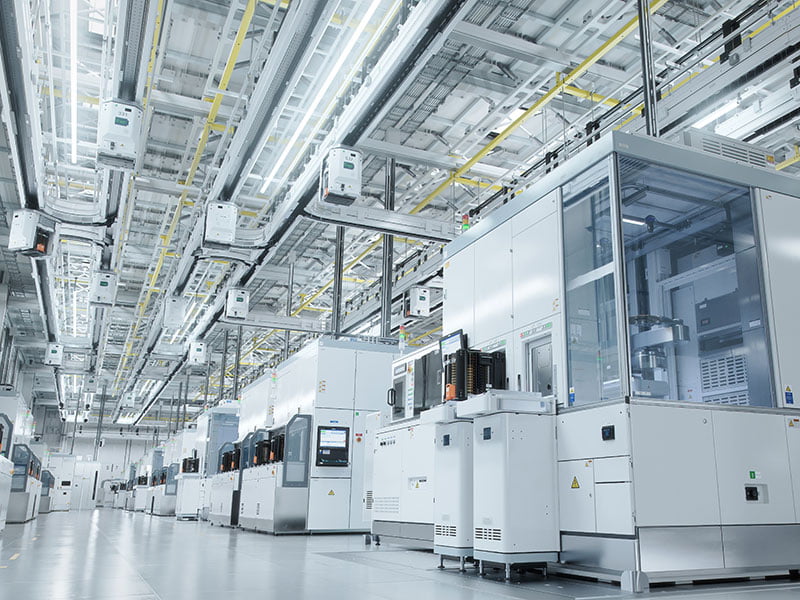For the first time in my living memory, we are seeing a growing global appetite for science and technology discovery driven by global disturbances such as the pandemic and climate change, and the related global economic repercussions.
There’s a pressing need for solutions and we are looking to deep technology for answers. And this excitement for deep technologies – and their potential to solve global problems – is creating a groundswell that is spilling over into governments and investors.
We are shifting from a decades-long focus on digital innovation to the creation of physical products.1
Globally, deep technology is facilitating this shift, with 83 per cent of deep tech innovators designing and building physical products. And 96 per cent of these products combine the capabilities of emerging technologies across the spectrum like synthetic biology, advanced materials, artificial intelligence (AI) and quantum technology, and 70 per cent are creating new patents related to their work.

As the number of deep tech startups globally rose from 29 per cent in 2019 to 44 per cent in 2017, investment trends have followed, growing by 14 percentage points – from 50 per cent to 64 per cent in the time frame.2
The European Union recently set forth a commitment for economic growth via deep tech innovation in its paper, A New European Innovation Agenda. This represents a bid to combat global inflationary pressures and develop resilient economies in a post-pandemic world where sustainable futures are increasingly tied to deep tech innovations.
Australia must follow suit and build on its world-leading academic capabilities and realise this immense opportunity in front of us.
Invention is not innovation
It’s a well-known narrative that Australia outperforms expectations in research outcomes. With 13 universities in the global top 200, we rank fourth in the world on academic prowess (on some scales) and punch above our weight when ranked against per head of population.
But if breakthrough research at universities was the key to becoming a global innovation powerhouse, Australia would surely be up there in the top 20 innovation nations. Yet Harvard University’s Country Complexity Index ranks us 87th globally instead. So, what are we missing?
One nuance we need to see in the policy agenda and national conversation is an understanding of the difference between research, invention and innovation, and the different supporting drivers and actors involved in each stage.
Research largely happens in universities, public institutions and specialist laboratories, and is decades away from a product or service being deployed. It is critical to providing the fundamental discovery and breakthrough that future products and services will be built on. Invention may follow and typically involves the creation of a patentable product and/or process.
Innovation is the process of taking new ideas or improved products and services and bringing them to market. It moves beyond research and invention and its actors or agents are companies and individuals, with a focus on commercial outcomes.
Without diminishing the importance of the policy drivers supporting research and invention, we do need to ask ourselves: are our policy settings encouraging, expediting and increasing innovation? What are we doing to equip the actors, enablers and funders to deliver innovation?
No one perfect model
For innovation to truly transform a nation economically, socially and environmentally it needs policies that are scalable, sustainable and systemic. It’s not enough to just import programs and policies from Israel, Silicon Valley, or London and expect the same outcomes.
Assuming that what works in one location and time will work in all locations and at all times is a sure-fire path towards repeated failure.
In Australia, this won’t be achieved simply by importing programs and policies. We must consider our local strengths, recognise the global landscape and what role we can play in it, consider what consistent policy levers we can set for long-term drivers of change and be willing to adapt and dial up and down those levers of change as the innovation ecosystem develops.
Get the balance right, and we will see growth of individual companies in specific technology domains, but a spillover effect that has incremental growth in jobs and innovation along the whole supply chain.
In setting these policy levers, we must consider four vital drivers of change: a long-term plan, funding, infrastructure and skills.
If you dream, dream big
Australia’s future economic prosperity and geopolitical leadership hangs on our ability to establish sovereign capabilities in future-critical industries.
But cultivating an economy in which homegrown future-critical deep tech companies flourish requires that business, investment and community align on a grand vision and supporting long-term policy plans.
We need a vision that encompasses the whole of society. Venture-fuelled economies like Silicon Valley, while impressive from the outside, do have systemic weaknesses that can lead to and increase the gap between those inside the system and those outside it.
For innovation to benefit the whole of Australia we need a broader, all-encompassing vision that enables innovation to go beyond just the invention of new technology and its introduction to market, to innovation that enables implementation of inventions across more sectors in the market creating a spillover effect of opportunity.
A case in point is WiFi and its plethora of hardware and software-enabled applications, including global ecommerce, smart cities and remote work opportunities. As an innovation, the spillover effects of WiFi show no signs of abating.
Australia is capable of technology breakthroughs that spawn entire industries. A clear national vision on how to galvanise trillions – not billions – of investment into bringing the next world-leading discoveries to market could see similar results as when former US President John F. Kennedy announced: “We choose to go to the moon in this decade”.
Show me the money
Realising a grand vision requires galvanising significant long-term investment well beyond the usual mechanisms of venture capital and taxation incentives, although these are important.
Australia’s R&D investment is woefully inadequate at 1.79 per cent of Gross DP, and declining. In comparison to other much-touted innovation nations, Israel is 4.9 per cent, South Korea is 4.6 per cent, Germany is 3.2 per cent, and the US is 3.1 per cent.
Government R&D investment must be structured to encourage more Australian companies to match or exceed the R&D investment of our innovation leaders like CSL.
This could help to combat recent data that demonstrates a reduction in funding levels for R&D within industry. Global innovation leaders spend between 10 to 15 per cent of revenue to invest in R&D to create future innovation pipelines.
Consider UMC, a joint venture between the Taiwanese government and a consortium of local companies, which was a catalyst for Taiwan becoming the global leader in semiconductor fabrication. The government’s US$35 million investment allowed Taiwan to become the global leader in semiconductor fabrication, creating a $147 billion industry accounting for around 15 per cent of GDP.
The initial investment in UMC also produced spinoffs from early-stage participants, creating a host of new companies. The policy also encouraged industry away from specific niches, to focus on building broader capabilities that would enable rapid design and manufacture of tailored chips.
All of this led to a thriving value chain, increased global demand from a diversified customer base and transformed the Taiwanese economy.
Government must also become a first customer to validate new innovations, and provide the revenue needed for deep tech and engineering companies to survive multiple ‘valleys of death’, while enabling subsequent capital raising from numerous other investment sources. But procurement policy commitments alone are not enough to deliver on this.
As an example, the US’s federal Small Business Innovation Research (SBIR) has run for some 40 years and, regardless of who is President, invests more than US$2.5 billion per year with an ever-increasing budget, and spans across 11 government departments from agriculture to energy and space and science.
This program surfaces the emergent innovation needs of departments and connects them to SMEs to build new innovation solutions with an engaged customer. By connecting innovation needs and procurement, these programs enable startups to become scaleups with a global market assured as they are directly solving problems for one of the world’s largest economies.
Imagine what we would see in Australia should a policy like this be implemented successfully across all agencies nationally?
If you build it, they will come
To create thriving innovation ecosystems the right infrastructure is critical.
We require infrastructure for research, invention and pre-scaling manufacturing. We have a taste of what both of these forms of enabling infrastructure look like with our world-leading National Collaborative Research Infrastructure Strategy (NCRIS).
NCRIS supports critical initiatives such as the Heavy Ion Accelerator Facility, which was installed in 1973 and continues to enable research and commercialisation in quantum dynamics, new materials, medical physics and space.
Without it, we’d be forced to send our space ventures to NASA for support instead. Beyond fundamental research it has enabled companies like Quantum Brilliance, whose quantum processors use synthetic diamonds that are implanted with nitrogen in the facility, to raise over $13 million to support its commercialisation journey.
We also require infrastructure such as manufacturing facilities with capabilities for multiple production lines as start-ups scale up. Sophisticated infrastructure development and manufacturing capabilities are largely beyond the investment capabilities of most small to medium enterprises (SME).
Facilities usable by multiple companies for product development and manufacturing would ensure the greatest utilisation of assets and lower the barrier for onshore development. This would lower the cost of entry and enable greater innovation onshore.
Infrastructure that enables long-term and diverse innovation involves careful consideration of investment into both existing resources and the right new resources to enable generational economic impact.
A particular set of skills
For investment to be deployed into realising a grand vision using onshore infrastructure, Australia must attract and grow exceptional specialised deep tech and manufacturing talent and develop adjacent capabilities across the ecosystem.
Economic growth and development require us to build increasingly more complex industries from an accumulation of productive knowledge. It is a hallmark of the continued growth of economies such as Israel, the US, Germany, Japan, South Korea and others.
The skills conversation cannot be solely centred around deeply technical skills. An innovation ecosystem capable of onshore manufacturing requires production-capable people.
We need experienced people who can run the manufacturing process, and this is both an opportunity for reskilling and importing talent. And we need to prepare the VET sector for adjacent enabling skills in the spillover opportunities.
It’s an opportunity to expand pathways for more Australians to participate in the type of prosperous future that is created when you become an innovation nation. Imagine how much science and technology talk will occur around the dinner table then!
Smell that? That’s a legacy
To transform our national economy and create pathways of opportunity for the nation, we must ensure the levers we create enable us to build a legacy for generations to come. Policy drivers must be embedded in our systems beyond the lifecycle of any government and must be tied to a bold vision.
When we make these systemic changes, we are creating an environment for perpetual innovation and economic growth. So, let’s be bold enough to lay down the policy and investment foundations now for future generations to come.
Sally-Ann Williams is Chief Executive Officer at Australia’s pioneering deep tech incubator Cicada Innovations. She has been involved in driving national engagement and change strategies in innovation, entrepreneurship, computer science and STEM education, including contributing to the COAG STEM Partnership Forum and the foundation of StartupAUS.
Footnotes
- https://www.bcg.com/publications/2021/overcoming-challenges-investing-in-digital-technology
- https://www.cicadainnovations.com/australias-deep-tech-opportunity
Do you know more? Contact James Riley via Email.

